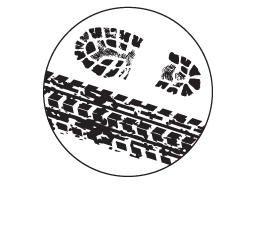Discipline Overview:
Footwear and Tire Track Evidence is often overlooked and underutilized at crime scenes yet can be vitally important in helping determine the movements of individuals entering, traversing and exiting scenes. These forensic examinations can provide information on the number of potential perpetrators, direction of travel, and type of footwear/tires which made the impression, thus helping investigators to include and exclude relevant shoes and vehicles.
Examinations can be performed on even partial footwear and tire track impressions to form conclusions regarding the level of association (or disassociation) of exemplars. By working with properly photographed, lifted and casted impressions, scientists can examine both class and randomly acquired characteristics to form a wide range of conclusions regarding the level of association of a particular shoe or tire. Conversely (pun intended), footwear impressions can be encoded and searched through a variety of databases to determine potential make and model of shoes allowing for investigative leads.
There are multiple footwear databases available to agencies for purchase to help determine potential make and model of the shoe which made a footwear impression. The Footwear Reference Collection Group (FRCG) has kept the Foster & Freeman FPX Footwear Database alive by working with agencies across the country who add encoded outsoles to the database and share their new entries with other collaborators. For more information on how you can be a part of this group, please reach out to a member of the subcommittee for more information.

Footwear and Tire Track Examination Subcommittee Chair

Emily Rice, NH, USA
Committee MembersReturn to Forensic Disciplines
Qualifications:
Footwear and tire track examiners are often also trained in another forensic discipline. Examiners may be latent print, firearms, or trace examiners, depending on the agency. It is recommended that examiners possess a bachelor's degree in a natural science from an accredited college or university.
A comprehensive training program under a qualified examiner should be completed prior to performing independent case work. Each lab will vary on their training program but, the ANSI/ASB minimum Qualifications and Training requirements to become a Footwear/Tire Forensic Scientist can be found here:
Continuing education is essential to keeping up to date with the discipline and ongoing research in the field.
Certification:
Standards:
- Forensic Science Standards Library | NIST
- OSAC 2023-S-0017 Standard for the Articulation of Footwear and Tire Interpretations
- OSAC 2022-S-0032 Best Practice Recommendation for the Chemical Processing of Footwear and Tire Impression Evidence
- ASB Technical Report 051 Scope of Work for a Footwear/Tire Examiner, 2020 (Errata 1, 2022), 1st. Ed.
- ANSI/ASB Standard 095 Standard for Minimum Qualifications and Training for a Footwear/Tire FSSP, 2020 (Errata 1, 2022), 1st Ed.
- Recommendation 050 Best Practice Recommendation for Photographic Documentation of Footwear and Tire Impression Evidence, 2021 (Errata, 1, 2022), 1st Ed.
- Recommendation 052 Best Practice Recommendation for the Detection and Collection of Footwear and Tire Impression Evidence, 2022, 1st Ed.
- Recommendation 126 Best Practice Recommendation for Casting Footwear and Tire Impression Evidence at the Crime Scene, 2020 (Errata 1, 2022), 1st Ed.
- Recommendation 049 Best Practice Recommendation for Lifting of Footwear and Tire Impressions, 2020, 1st Ed.
- Recommendation 021 Best Practices for the Preparation of Test Impressions from Footwear and Tires, 2019, 1st Ed.
- Standard 099 (2022) Standard for Footwear/Tire Examination Proficiency Testing Program, 2020, 1st Ed.
- Standard 137 Standard for Examination and Documentation of Footwear and Tire Impression Evidence, 2023, 1st Ed.
Resources:
For more information about Footwear and Tire Track Examinations:
Texts:
- Forensic Footwear Evidence, Bodziak, William J., 2017
- Tire Tread and Tire Track Evidence: Recovery and Forensic Examination, Bodziak, William J., 2008
- Footwear Evidence, Abbott, John; Germann, A. C.
- Footwear Identification, Cassidy, Michael
- Tire Imprint Evidence, McDonald, Peter
- Forensic Tire Impression Identification, Nause, Lawren
- Footwear the Missed Evidence, 2nd Ed., Hilderbrand, Dwane S.
- Footwear Impression Evidence: Detection, Recovery and Examination, Bodziak,William J.
- Tire Tracks and Tread Marks, Given, Bruce W.; Nehrich, Richard B.; Shields,James C
- The Complete Handbook of Athletic Footwear, Cheskin, Melvyn P.
- Forensic Comparative Science: Qualitative Quantitative Source Determination of
- Unique Impressions, Images, and Objects, Vanderkolk, John
- Tread Design Guide
Websites:
- American Academy of Forensic Science
- Canadian Society of Forensic Science
- Footwear & Tire
- Footwear_Tire Process Map_June 2022.pdf
- Footwear | NIST
Journals that publish FW/TT articles:
- Forensic Science International
- Journal of Forensic Identification (IAI)
- Journal of the Forensic Society
- Journal of Forensic Sciences (AAFS)
- Journal of Forensic Science and Technology
- Science and Justice
Important Research Articles:
Organizations relevant to this Discipline:
- Organization of Scientific Area Committees for Forensic Science (OSAC)
- American Academy of Forensic Sciences (AAFS)
- ANSI National Accreditation Board (ANAB)
- American Association for the Advancement of Science (AAAS)
- National Institute of Standards and Technology (NIST)
Ideas for more Research Projects:
- OSAC Research and Development Needs | NIST
- Footwear Impression Evidence: A NIST Scientific Foundation Review | NIST
FW TT Research and Development Needs:
Information about Proper Collection of Evidence: